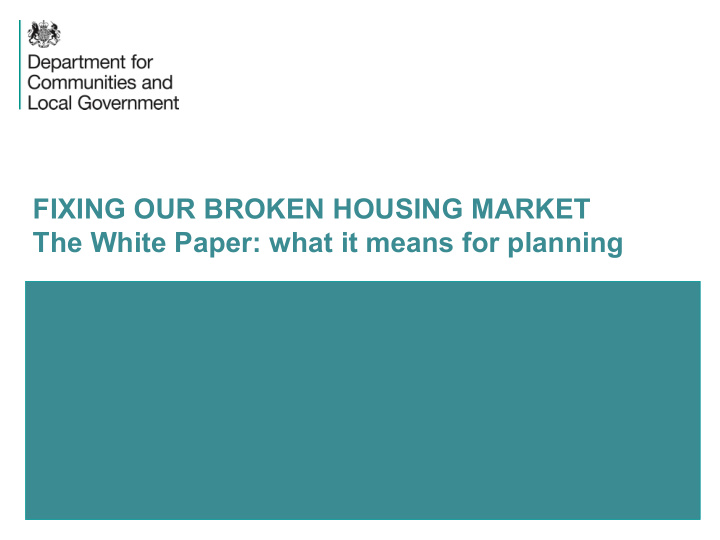



FIXING OUR BROKEN HOUSING MARKET The White Paper: what it means for planning
Context: housing is increasingly unaffordable By 2020 only 25% of 30 year olds will own their home The average London home made its owner more than £22 an hour during the working week in 2015 – much more than the average Londoner’s hourly rate Rental costs are also rising: for the average couple renting, rent now equals 46% of income 2
The response: a comprehensive four-point plan 1. Planning for the right homes in the right places (plans and land) 2. Building homes faster 3. Diversifying the market 4. Helping people now “We need to build many more houses, of the type people want to live in, in the places they want to live. To do so requires a comprehensive approach that tackles failure at every point in the system.’’ The Rt Hon Theresa May MP
The White Paper: how it fits together A focus on delivery and what we need to achieve it: Helping Market Plans Land Delivery people diversity now Underpinned by a number of cross-cutting themes: • Capacity • Community Cross- cutting themes • Digital / transparency • Accountability The White Paper works with the grain of the existing system – but gives more flexibility, and additional tools to drive delivery
Planning to meet housing requirements Plans must be in Requirement for place… but more regular updating flexibility over how More standardised Stronger emphasis assessments of on meeting requirements requirements Further support for Better working Process neighbourhood across boundaries improvements planning Image: Stevenage Borough Council
The new framework for plan-making
Making land available – and better use of it More transparent More proactive role land ownership and for authorities in interests assembly/disposal Further support for Boosting small, brownfield and medium and rural public sector land sites Stronger Delivering new Enhanced tests for expectations on communities Green Belt release density and design
Improving delivery
Improving delivery More certainty over Action on fees and 5 year supply capacity Aligning growth Reform of with national and developer local infrastructure contributions Greater ability to Delivery test: Better information take build rates into consequences for on build-out account and under-delivery incentivise delivery
Market diversity and helping people now Using Accelerated Further support for Construction to custom build diversify & innovate Encouraging build Supporting housing to rent (separate associations and consultation) authorities to build Meeting specialist More flexible A fairer deal for housing needs and approach to renters and affordable home preventing leaseholders ownership products homelessness
Cross-cutting/underpinning themes Capacity - Confirmed increase in planning fees (potential for more) - Possible introduction of appeal fees - £25m of capacity funding for areas of high housing need Community - Further support for neighbourhood planning groups and custom build - Scope for NPs to do more (housing numbers, design, Green Belt boundary) - Stronger emphasis on early pre-app discussions involving communities Digital/transparency - Improving digital access to planning data and data standards for plan - More comprehensive and accessible data on land ownership/interests - Greater transparency on delivery – by authorities and builders Accountability - Making authorities more accountable for whether plans are delivered - Making developers more accountable for delivering consented schemes - Holding utility companies to account for securing necessary connections
White Paper asks and offers For local authorities For industry For people and communities The offer: The offer: The offer: • Simplified plan-making • A better resourced system • More ability to influence the location and look of homes • Additional fees/capacity • Further process improvements (e.g. conditions, newts) • More homes of the right type • Funding for infrastructure and in the right locations to • Partnering with small/medium • More certain land supply meet local needs firms and promote modern • Better tools for land assembly methods of construction • More certainty about where and build-out development will happen, • Action on skills and utilities • Backing for innovative delivery infrastructure and delivery on • Stable investment framework, models permissioned sites including products for rent. • £1.4bn additional investment in The ask: new affordable homes The ask: • Plan for housing requirements • Greater security for tenants in • Build more homes – and swiftly • Work constructively to address new build to rent homes where permission is granted unmet requirements • Engage with communities • Keep working on your plans • Invest in research and skills • Be proactive in assembling • Deliver the infrastructure land and leading development needed • Take action to encourage site • Invest and support developers delivery and social landlords in building more homes
What else? Implementing the Housing and Taking forward the Neighbourhood Planning Act 2016 Planning Bill Key measures include: Key measures include: • Requirement for authorities to • Brownfield registers and permission maintain policies for key strategic in principle (regulations this spring) priorities • Extension of performance regime to • Strengthening and streamlining non-major development neighbourhood planning • Allowing some housing as part of a • Improving the use of planning nationally significant infrastructure conditions to support the faster project (spring) build-out of permissions • Compulsory purchase reforms • Further compulsory purchase reform (programme of implementation (includes making the calculation of underway) compensation clearer and fairer)
What next? • Consultation through the White Paper on new proposals – Annex A has 38 questions (plus a separate consultation on build to rent) • Further consultations to follow as indicated in the White Paper • We are working towards a revised NPPF in the summer • Passage of the Neighbourhood Planning Bill • A renewed focus on implementation and working with local areas to deliver the changes that are needed The White Paper consultation closes on 2 May 2017 we prefer responses online: https://www.surveymonkey.co.uk/r/QLLWWSS or via email: planningpolicyconsultation@communities.gsi.gov.uk
Recommend
More recommend